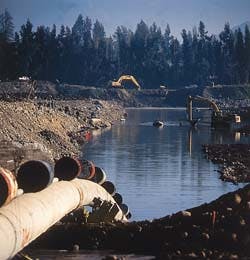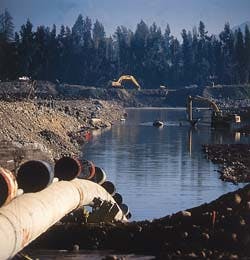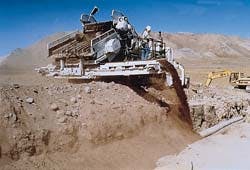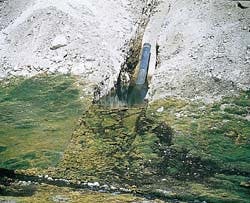GasAndes will flow by mid year
Warren R. True
Pipeline/Gas Processing Editor
Crossing the Maipo River progresses in San Bernardo near Santiago (Fig. 2).
To protect the pipeline coating and permit line movement in unstable soil, GasAndes employed an "Ozzie Padder" machine to deposit smaller fill around the pipe in areas such as the one shown here, in the shadow of the dormant Volcano Maipo (Fig. 3).
Enviornmental restoration was often by hand, as here in vegas in the Cordillera Los Andes. Such restoration included sandbags, silt dams, and hand-removal and restoration of top growth (Fig. 4). An important gas pipeline in the Southern Cone of South America will start up later this year in time for the region's Southern Hemisphere winter.
Gasoducto GasAndes S.A., Santiago, Chile, has completed pipelay on the $350 million, 287 mile, 24-in. line from La Mora, state of Mendoza, Argentina, to Santiago.
Deliveries will be made into the line from Transportadora de Gas del Norte (TGN), Argentina's gas-transmission system for the northern part of the country (OGJ, Mar. 31, 1997, p. 73).
The line's significance lies in part in how it draws the historically antagonistic countries into closer interdependence. And it is also the first gas-import project to one of the region's largest and most important cities.
The line will bring gas to fuel several power plants supplying electricity to Santiago. In addition, Metrogas S.A., Santiago's gas distribution company and a partner in GasAndes, will also be receiving gas for the city's first natural-gas distribution system, which is currently being installed.
NOVA Gas International, 56.5% interest holder in GasAndes and its project manager, has said the line's initial capacity will be 119 MMcfd this year, expanded to 252 MMcfd in 1998, 427 MMcfd in 2002, 574 MMcfd in 2005, and to 686 MMcfd by 2016.
GasAndes says growth in the system is driven by when each of the four power plants comes on stream, planned increases in demand at each plant, and planned demand growth at Metrogas.
Other partners in GasAndes are Chilgener S.A., Chile's second largest power generator and a widely held, publicly traded company (15%); Metrogas (15%); and the Argentine company Cia. General de Combustibles (13.5%).
NOVA Gas International also holds a 19.1% stake in TGN (see accompanying box on NOVA Gas International's involvement in Latin America).
Earlier, GasAndes announced plans for a 68-mile extension to Quillota, 19 miles from Valparaiso on the Pacific coast, but has since dropped those plans. The company says Empresa Nacional de Electricidad S.A. (Endesa), owner of the power plant at Quillota, will build the extension.
Construction of Gas Andes' main line has traversed desert areas of Argentina and mountains and an environmentally sensitive river valley in Chile. Desert portions proceeded with traditional trenching, says GasAndes, while much of the Chilean portion encountered solid rock along its right-of-way.
The market
This is the first major gas development into Chile. Before now there has been no delivery infrastructure to speak of either in the country or in Santiago.
The only gas production has been in the far south of the country. There, a short gas line connects the Posesión gas plant operated by the Chilean oil company Empresa Nacional de Petróleo (ENAP) with a plant operated by the Argentine company Pérez Companc. That contract expires this year.
And some Chilean gas, also in the far south, flows through a short line to provide fuel for methanol production.
GasAndes says that in the south, the small city of Punta Arenas provides a miniature model of what Santiago could become. That city's taxis and buses, home heating and appliances, are fueled by natural gas produced in association with local oil production.
In general, says GasAndes, domestic gas demand has been for bottle gas (LPG). The Santiago gas-distribution infrastructure being installed by Metrogas will tie in with the existing, limited "town gas" (naphtha) system, thus easing the transition to natural gas.
Thermal power plants to date have burned coal to generate electricity. The focus of gas development for the city has, therefore, been environmental.
Santiago's growing pollution problems stem from this use of coal for power generation as well as from use of diesel and fuel oil. Additionally, the city is often choked with black smoke from the yellow buses of its transit system.
The surrounding mountains have the same effect as in Los Angeles and Denver: For much of the year, vehicular and power-plant emissions are trapped over the city in a dirty brown haze.
Table 1 [25359 bytes] presents Gas Andes' analysis of Santiago's air pollution problems by 2002 and 2017 with and without the use of natural gas in the city.
There will be two delivery points into Santiago to Metrogas. City Gate 1 will be in the south of the city in the Puente Alto district; City Gate 2 will be on the city's southwest side in the district of San Bernardo (Fig. 1 [96621 bytes]).
Two intersecting rings are under construction to deliver gas to Santiago via Metrogas. Metrogas' deliveries will build to its contracted 1.7 million cu m/day (cmd; 59.5 MMcfd) by yearend 1997 with additional volumes to begin flowing in May 1998.
The other recipient of gas this year will be the gas-fired power generating plant Central Renca, owned by Sociedad Electrica Santiago S.A. (ESSA), in the city's northwest section. Construction of the plant will be complete in early 1998, says GasAndes.
The plant is contracted to take 1.74 cmd (60.9 MMcfd) on Oct. 1, 1997, just as the South American summer is about to start.
The three other gas-fired electric generating plants to be built by 2002 are Colb#n S.A., on-line in May 1998 and to take 1.64 million cmd; Endesa, in October 1998 for 1.684 million cmd; and Chilegenero (owned by Chilgener) in 2001 for 1.74 million cmd.
Colb#n S.A. is a recently privatized company owned by the Mathe Group of Chile, Iberdrole of Spain, and Tractebel of Belgium.
By May 2001, at peak delivery under current contracts, the four power plants will take 6.804 million cmd (238.14 MMcfd). Metrogas at peak delivery that year will take 2.905 million cmd (101.68 MMcfd).
Initially, GasAndes will move gas to Santiago by existing compression at the TGN compressor station in La Mora. In May 1998, the first compressor station will be installed at La Mora.
The initial requirements there are for two Solar Taurus type 70 turbo compressors of 6,600 kw each. GasAndes will install the compressors; TGN will operate these and all facilities on the Argentine portion of the line.
As flows increase, additional compression will be required along the pipeline at three other locations, two in Argentina and one in Chile, for a total of 68,000 kw including La Mora.
On the Argentine side of the line, compression will be installed at kilometer point (KP) 240, or 240 km west of La Mora, for start-up in 2001, and at KP 120 for start-up in 2003.
In 2004, compression will start up on the Chilean portion at KP 31 (or, 31 km west of the Argentina-Chile border).
The pipeline
NOVA Gas International de Chile has been project manager for Gasoducto GasAndes which will be final operator of the line. Engineering was by Arcan Ingenieria y Construcciónes S.A., Buenos Aires, with offices in Santiago.
The following parameters governed pipeline design:
- Maximum allowable operating pressure (MAOP): 9,930 kPa
- Gas temperature (maximum compressor discharge): 60° C.
- Gas temperature (maximum general): 35° C.
- Gas temperature (minimum): -5° C.
- Ambient temperature (maximum): 40° C.
- Ambient temperature (minimum): -29° C.
- Below ground design temperature (minimum): -5° C.
A total of 476.7 km (296.03 miles) of pipe was received for the project; all the main line pipe is 24 in., Grade X-65. The actual amount of pipe used was 462 km; the reduction resulted from route changes in the final design, says GasAndes.
Building the line will end up costing approximately (U.S.)$350 million: construction $140 million; material $80 million; and the remaining $130 million, divided among engineering, legal, land, and community relations.
Pipe was manufactured at two pipe mills in two countries. Confab pipe mill in Pindamonhangaba, Brazil, supplied the 22.51, 13.51, and 11.26 mm W.T. pipe, and the SIAT mill in Valentin Alsina, Argentina, manufactured the 9.85 mm W.T. pipe (16.6 km to Chile; 30 km to Argentina) and 9.38 mm W.T. pipe (93 km to Chile; 87 km to Argentina).
Confab pipe, 48.6 km (10,025 metric tons), was coated at its plant. SIAT pipe, approximately 426.7 km (59,459 metric tons), was coated at SOCO-RIL Worldwide Pipe Coating Contractor, which sits adjacent the SIAT plant.
GasAndes says line pipe was manufactured to API 5L with supplementary company specifications. Resistance to fracture initiation and propagation was achieved by specifying minimum levels of fracture toughness for pressure-containing components and line pipe, depending on the level of design stress.
A minimum Charpy V-notch energy value of 40 Joules was required, -5° C. buried and -29° C. aboveground.
Pipe and components were welded according to API 1104 and with approved welding procedures. All girth welds were inspected by radiography.
Pipeline class locations and required wall thicknesses were designed and built according to ASME B31.8 and Chilean Decree No. 254.
Pipe wall thicknesses required for proximity, says GasAndes, depend upon pipe pressure, diameter, class location, and distances to houses.
Pipe wall thickness for the pipe supplied to GasAndes-9.38 mm (379.8 km), 11.3 mm (5.2 km), 13.5 mm (42.8 km), and 22.5 mm (2 km)-reflect 0.72, 0.60, 0.50, and 0.30 design factors.
Valves were manufactured to API 6D with supplementary company specifications by Cooper Cameron Valves, Ville Platte, La.
The gas-discharge temperature, says GasAndes, is too high for use of standard ANSI Class 600 valves. In this case, the company could either specify ANSI 600-lb rating valves (built with special materials and called "alternative weld end") or move up to the next highest class of valves.
After analysis, GasAndes chose to standardize on the Class 900 valves.
In response to public concerns for safety both during construction and operation, NOVA Gas has employed the strictest codes available. This meant, for example, use of Canadian environmental codes whenever they exceeded others that were acceptable.
For coating, specifically, NOVA Gas chose a Canadian specification (CSR-A245.21 "External Polyethylene Coating for Pipe") which allowed the use of high-density polyethylene (HDPE) rather than low-density PE.
The coating is a three-layer extruded polyethylene; minimum coating thickness on any joint of pipe is 1.5 mm.
Girth-weld coatings were first sandblasted, then coated with mastic and Raychem's HELP 60 shrinksleeve. Coating "holdiays" are repaired with PERP 80 patches.
Scada, metering
The $1.2 million supervisory control and data acquisition (scada) system, OASyS from Valmet Automation (Canada) Ltd., Calgary, consists of a master gas-control center in Santiago adjacent City Gate 2. The center initially controls three meter stations and seven remote block valve sites in Chile and Argentina.
A contingency control center, capable of assuming system control in an emergency, is also situated in Santiago but at some distance.
In addition to monitoring and control, the scada system interfaces with GasAndes' corporate network and its business information system.
Valmet says that OASyS Version 6.0 runs on all three software components: XOS (operator stations), CMX (real-time database), and XIS (historical data storage).
The system uses Hewlett-Packard computers running HP-UX Version 10.20 for the CMX and XIS functions. Compaq computers running Windows NT Workstation 4.0 are for the XOS human-machine interface.
Significant about the GasAndes project, says Valmet, is the unusually large projected future expansion of compression capacity and hence gas throughput. OASyS will be able to handle this growth by flexible and highly distributed architecture.
The master control center includes dual HP 9000 Model C160 CMX/XIS servers, two dual-headed XOS operator stations, an engineering and maintenance station, and a projector XOS workstation.
The CMX/XIS host performs a secondary role as OASyS' management station server. This server provides a repository for all the system source code and displays.
For the XOS function, the management station client workstation provides the maintenance and source environment for all XOS displays. The contingency control center has a single HP 9000 Model C160 CMX/XIS server, and one dual-headed XOS operator station.
The master site uses a dual LAN to ensure reliable system connections.
An additional terminal server communication port is supplied for dial-in access and service support at both the main and contingency control centers.
Metering on the GasAndes system consists of an inlet station in La Mora owned and operated by TGN and two outlet city-gate meter stations owned by GasAndes. City Gate No. 1 is 1.38 million k-cal/hr; City Gate No. 2, 2 million k-cal/hr.
Each city-gate meter station consists of two 12-in. autoadjust turbine meters, two in-line gas heaters (1.38 million k-cal/hr each), and two pressure/flow control valves.
Additionally, says GasAndes, each meter station will contain Bristol Babcock flow computers and Daniel gas chromatographs to allow for real-time gas measurement.
Construction of meter stations, except La Mora, began in January; construction on La Mora has since commenced. All will be on-stream date in June.
The GasAndes operations center is being built on a 4-hectare (40,000 sq m) plot on the outskirts of Santiago, in the community of San Bernardo. The expected opening date is July 1997.
The building consists of approximately 900 sq m of office area and 900 sq m of technical workshops and warehouse space.
The main construction contractor is a consortium formed by Constructora SPS and Arcan S.A.
Environmental measures
In terms of terrain, construction was divided into five zones.
- M1 runs over the Pampas in Argentina to the base of the Andes Mountains. It is mostly desert with several fault zones underlying the construction route.
- M2 consists of the area from the Pampas (at 1,200 m elevation) to the Argentina-Chile border at 3,700 m elevation. This area, site of old volcanic activity, exhibits soil that is rich in volcanic ash.
- M3 is 78 km of environmentally pristine valley of solid rock and high alpine meadows following the Maipo River. The route required nine crossings of the river (Fig. 2).
- M4 essentially leaves the valley because it narrows and is crowded with industry, crosses another ridge of the Andes Mountains, and runs along a series of ridges.
- M5 runs through flat agricultural land and makes the last crossing of the Maipo near Los Morros. There the pipeline was installed by open cutting the 470 m wide river flood plain.
GasAndes says that the challenges of the project began with the need to fulfill environmental requirements of the environmental regulators. In Argentina, the process for applying for environmental permits was well established and thoroughly understood by industry and its regulators.
However, on the Chilean side of the project, environmental review, under law which has yet to be ratified by the government, made it difficult to obtain all the information required for the environmental approval.
GasAndes says it voluntarily submitted to the environmental process in keeping with NOVA's principles of complete compliance with local laws as well as application of industry "best practices," where these exceed local requirements.
The review process, in Chile taking approximately 20 weeks, hampered start of construction.
Following approval in Argentina, construction of the pipeline began.
Areas of concern there were primarily associated with the environmental reserve in and around Laguna Diamante. The pipeline itself runs within 2 km of the laguna, says GasAndes whose concern it was to minimize disturbance to the reserve.
The high elevation of this lake in the caldera of a volcano and the present cone of Volcan Maipo gives almost a moonscape beauty (Fig. 3).
Also, given the dry, barren conditions of the high Andes in this location (M2), vegas are an important part of the ecology, says GasAndes.
These are wetlands saturated throughout the year which act as a refuge for wildlife to feed on the plants that grow abundantly there. In the largest vega of the area, Vega del Yaucha, one commonly finds guanacos (a llama-like mammal).
In order to protect Vega del Yaucha, GasAndes minimized the crossing of this vega.
And, in order to ensure the successful re-establishment of the sod layer, individual blocks of sod were removed along the ditchline and manually watered during days that the ditch was being excavated.
The pipeline was laid and trench backfilled; then the sod was replaced into a patchwork that is now, says GasAndes, less than one growing season later, beginning to grow back (Fig. 4).
In Chile, upon receipt of the environmental approval, construction began rapidly. However, there remained several hurdles in the acquisition of related permits (for example, tree cutting and water crossings) that the relevant authorities would not issue until approval of GasAndes' overall environmental impact study.
The environmental approval from the regulator (Comisión Nacional del Medio Ambiente-Conama) came with several conditions that included both environmental and engineering constraints.
From the engineering perspective, GasAndes was required to increase the wall thickness in two communities, install the pipe at extra depth in one section, and work with a mutually agreed upon technical auditor to review the engineering and construction of the pipeline.
Environmental conditions included monitoring areas of concern, movement of the right-of-way from one side of a Maipo River valley to another to avoid plant species which might be damaged by construction, install signs, and implement forest-fire protection measures.
GasAndes says that the environmental approval process was difficult for both the company and Chilean regulators. The company had the pressure of meeting difficult project deadlines and construction constraints in the form of winter snows in the high country and seasonal flooding in the spring and early summer.
Chilean regulators were faced with the prospect of assessing a host of large industrial projects under way in Chile, each with large environmental impact studies to be assessed. And like regulators worldwide, says GasAndes, had fewer technical and administrative staff than they would prefer to meet their responsibilities.
GasAndes says environmental organizations have also been active in the communities along the right-of-way.
These groups, says the company, would publicize isolated pipeline incidents from around the globe, taken out of context, then demand guarantees that no such incidents would occur in Chile. For example, GasAndes was expected to respond in "sound bites" to the highly technical subject of stress corrosion cracking.
No company can guarantee that its system is completely infallible forever, the company says; opponents took this truthful answer to fuel fires of concern.
The company notes that in May 1997, it will begin reseeding and tree-planting and by yearend will have planted more than 100,000 trees along the Chilean right-of-way.
What's left
GasAndes expects to complete hydrostatic testing as well as installation of the communications system by June 1 and air drying of the line by June 10. Commissioning and construction of the scada system are set for completion by the end of June.
Gas will flow in early July.
Copyright 1997 Oil & Gas Journal. All Rights Reserved.



